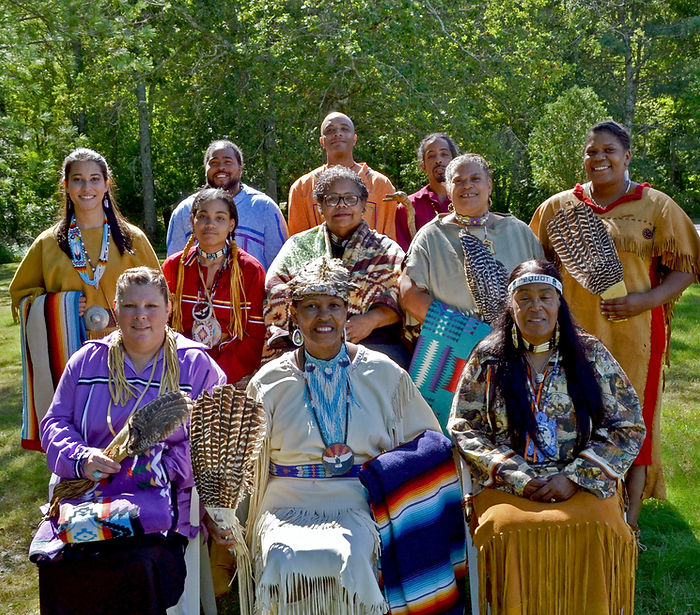Today we commemorate the day our tribe was acknowledged by the federal government after a long tedious journey which started in 1978. We acknowledge the work, time, and effort it took to obtain Federal Acknowledgement. The same year the Office of Federal Acknowledgment was created is the same year we submitted our letter of intent for Federal Acknowledgement, we were number 35. During that time our Tribal Nation experienced what many other Nations experienced, arguing, disputes and disagreement.
In 1973 Connecticut established Public Act 73-660 the Connecticut Indian Affairs Council (CIAC), defined the five state-recognized tribes as “self-governing entities
possessing powers and duties over tribal members and reservations” and transferred Indian Affairs to the Department of Environmental Protection. The CIAC legislation magnified our disputes and disagreements between each other for state legislatures to witness during proceedings.
Two families both of who were Eastern Pequot’s claimed the same history on the same land base at the Lantern Hill Reservation in North Stonington, CT. The Eastern Pequot and the Paucatuck Eastern Pequot’s, are both one and the same. Unfortunately, the Paucatuck Eastern Pequot’s challenged the Eastern Pequot’s rights to the land and a seat on the CIAC.
In the summer of 1982, the Paucatuck Eastern Pequot’s tried to eject the Eastern Pequot members who resided on the Lantern Hill reservation. The Paucatuck Eastern Pequot’s signed letters on July 23, 1982, which were sent to all members of the Eastern Pequot’s. Eastern Pequot’s strongly protested this attempt to remove them from the reservation to the CIAC. Eleven years after the Eastern Pequot submitted their letter of intent, the Paucatuck Eastern Pequots submitted a letter of intent (1989). Using the-same history the Sebastian family used, the Paucatuck Eastern Pequot’s Federal Acknowledgement petition continued to debate and discredit the Eastern Pequot’s.
In a IS 89 interview, Paucatuck Eastern Pequot Helen Legault indicated that the views she had held since the 1930s remained unchanged: Legault said, “My family is the only legal Indian family that can live on the reservation. We have documented proof that we are native American Indians. But now we have squatters on our reservation who claim that they are Pequot’s.” These people have taken over and the government does nothing about it. “What I want to know is why the state let Non-Indians challenge a state-recognized indigenous tribe’s seat, especially since these people were proven non-Indians since 1977!” says Legault, emphatically
(Tomaszews.ci, Lea, Ponland Powwow Airs Indians’ Woes, History. Newspaper).
The families representing the Eastern Pequot group maintained their claim they were Eastern Pequot and was confirmed through 1800s Connecticut historical reports and ship manifests indicating that Moses Brushell the father of Tamer Brushell, the Eastern Pequot Sebastian line progenitor was in fact Eastern Pequot. He spent many years out at sea while his two children were taken care of by other Eastern Pequot members and resources from CT State overseers who helped with his children.
At a time when the US was going through many changes and events; wars, social unrest and extreme racism, this dispute went on from the 1930s onward until around the time just before the Federal Acknowledgement process was established (1978). Eventually, both groups decided to put this dispute behind them for the greater good of the tribe. By combining leaders from both groups, the tribe was able to create a constitution and start anew. Renamed the Historical Eastern Pequot Tribe.
Federal and CT Indian Statutes specifically state a tribe has the inherent sovereign right to determine its own membership. The right to self-govern, decide who is allowed to reside on the reservation, participate in the tribal government, and taxation.
Foxwoods and Mohegan Sun Casinos were built by 1996 just as the Eastern Pequot tribe was gaining momentum towards Federal Acknowledgement. Several experts were brought in as witnesses, and thousands of documents were submitted to support both Federal petitions. Number 35 and 113 Eastern Pequot and Paucatuck Eastern Pequot respectively.
With over 30 Volumes containing thousands of pages of historical documents representatives from the BIA stated this was the best petition they have ever seen.
In March 2000, under the Clinton Administration, Kevin Gover, the Assistant Secretary of Indian Affairs under the BIA announced their Proposed Finding for a positive preliminary decision for Federal Acknowledgement. A notice placed in the Federal Register was based on a determination that the now-named Historical Eastern Pequot tribe satisfied criteria through 1973. It was announced that both the Eastern Pequot Tribe and the Paucatuck Eastern Pequot’s would be considered simu1taneously with the #35 Eastern Pequot Tribe’s petition.
By June 24th 2002, both petitioners, #35 and #113 were formally recognized as the Historical Eastern Pequot Tribe under the Bush Administration. The federal register at the time addresses their conclusions about the 1973 period; “more specifically the political processes of the entire Eastern Pequot Tribe bridge the two petitioning groups in that their crucial focus is on controlling and maintaining access rights to a single historical reservation established for a single historical tribe. This final determination concludes that there is one group encompassing both current petitioners.
The evidence presented is sufficient to meet the requirements for demonstrating social community from 1973 to the present, even though, from 1973 to the present, the petitioners have developed into increasingly separate social segments. Each of the major segments, EP and PEP, has significant internal social cohesion. The segments are united by the overall political processes, even when these are illustrated primarily by political disagreements over the Lantern Hill reservation.
There is no requirement in the regulations that social relationships be distributed uniformly throughout a community nor that they be amicable.”
The Eastern Pequot Tribe was held to a higher standard of perfection when seeking Federal Acknowledgement. A few events worth mentioning which are similar in scope, President Obama in April 2011 released his birth certificate to prove his citizenship, or the entire US population reeling in the Jan 6th 2021 attack on the capital. while watching live, it felt like the country was falling apart. The US didn’t fall nor waver, nor did the Eastern Pequot’s. Leadership within the Eastern Pequot’s are determined by us because we are a “self-governing entity possessing powers and duties over tribal members and reservations”, they are not determined by another court or forum like the CIAC (Connecticut Indian Affairs Council).
The year 1973 is highly important as a precursor to the argument that would be used to dismantle the ruling made by Kevin Gover the Assistant Secretary. That particular year, 1973 is important because it is the re-start for the tribes in Connecticut through legislation and agreements established within the Connecticut Indian Affairs Council (CIAC). Many disputes came to the forefront during this time The social context of the political climate is also important because it helps paint a picture of what was going on during that time. The Wounded Knee Occupation Movement (1973), The Trail of Broken Tears (1972), the First National Day of Mouming at Plymouth Rock (1970)
The State of Connecticut and several towns rallied together to oppose the proposed finding. An 80- page document was sent to the BIA in September 2002 claiming both tribes didn’t exist from historical times to the present. The state urged the new Assistant Secretary Neal McCaleb to overrule a decision made by his predecessor Kevin Gover.
On October 14th (Columbus Day) 2005 the State of Connecticut and the neighboring towns succeeded in appealing Federal Acknowledgement for the now named Historical Eastern Pequot Tribe. A fax was delivered, not a call.
The BIA issued a “Reconsidered” Final Determination and was posted on the Federal Register. Never in the history of the Federal Acknowledgement process has a tribe received “2 Positive” findings and had it reversed. It read on “September 26,2002, the State and the Towns of Ledyard, North Stonington, and Preston, Connecticut (Towns) also filed requests for reconsideration of the Final Determination with the Interior Board of Indian Appeals (IBIA) under the provision of25 CFR 83.11.
On May 12,2005, the IBIA vacated and remanded the FDs for reconsideration pursuant to 25 CFR 83.1 1 (d)(2) and (e)(1O). The IBIA ruled that the Final Determination incorrectly relied on “the State’s continuous relationship and implicit recognition of the Eastern Pequot as a political entity as ‘additional evidence’ in support of demonstrating criteria 83.7(b) and 83.7(c) when the other evidence for a particular time period was insufficient” (41 IBIA 17). The IBIA concluded: “that the State and Towns have satisfied their burden of proof to show that a substantial portion of the evidence relied upon in the Assistant Secretary’s determination was unreliable or of little probative value” (41 IBIA 23).
The CIAC (Conn Indian Affair Council) in 1973 embodied the civil protests between a tribe who have effectively tried through different mediums to establish leadership and independence within an environment not suitable to any group. The Treaty of Hartford established the relationship between Connecticut and Eastern (Ninigret) Pequot’s which brokered the long-term relationship between the Tribe and Connecticut. Land-in-trust for Eastern Pequot’s for eternity, assistance for sustainability throughout the relationship from Colonial Times to the present times.
The disputes between each other at most times not peaceful demonstrate a civil war of sorts. Many cultures around the world including the US have gone through some sort of civil unrest to the point of violence. While some disputes on the Eastern Pequot Reservation and the CIAC were civil, some have resorted to force. Connecticut used this dispute between families to justify its agenda for a never seen before “redetermination”.
Although not required, both families resolved their disputes through shared tribal legislative processes and shared tribal Sovereign power by joining together with a joint constitution. The new Eastern Pequot constitution shared the power by adding 5 more seats to the 9, making it a 14 person council structure still used today with a mix of both families including an Eastern Pequot family who resided on the Lantern Hill Reservation, the Randalls. Instead of Connecticut celebrating the progress, especially because of the history of the CIAC, they took the opportunity to use these disputes to “pursue” a redetermination.
How can we determine our membership if other governments, agencies, and administrations keep denying us the opportunity to have a relationship with the highest law (federal) of the land we originally inhabited, Turtle Island?


